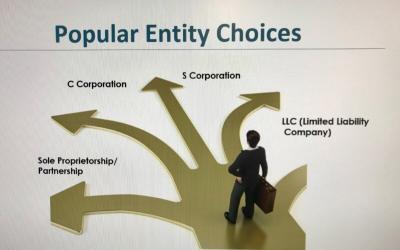Whether you’re an accountant, tax advisor, coach, or consultant, your clients inevitably turn to you for insight into how to improve their business’s bottom line. One of the questions they might ask is what is the best business structure?
You need to be ultra-careful in advising customers about this because it’s unlawful to offer legal advice without a license to practice law. However, you can give insight that’s pertinent to your certified area of expertise and credentials, and of course, direct clients to the right resources for legal guidance.
And, after a client has decided on a business structure, you can help them make the transition by assisting them in completing and submitting the necessary forms. It is not considered the practice of law to file business registration and compliance paperwork for clients. And by doing so, you can increase revenue for your business and provide additional value to your customers.
Let’s take a quick look at some of the considerations that will come into play as your clients contemplate what is the best business structure.
Factors to Discuss With Your Client
- Owners’ Liability Risks – How much personal legal and financial risk an owner is willing to assume will influence which legal entity type to choose. Keep in mind that some types of business have a greater potential to run into litigious situations and significant debt than others. Formally registering a company as an entity that’s separate from its owners offers greater personal liability protection than operating an unincorporated business.
- Tax Impact – The IRS (states and other tax authorities) will apply taxes to business profits according to a company’s legal structure. Some structures are set up to have taxes flow through to the business owner’s personal tax returns while others result in the business paying as its own tax-paying entity. Under some structures, business owners pay a bigger percentage of their earnings for Social Security and Medicare taxes. Your clients will want to weigh their options carefully to determine which scenario will offer them the best tax outcomes.
- Ownership and Management Flexibility – Different business structures have different ownership structures to consider. When more than one owner is involved, things can get complicated, so it’s critical for clients to understand the advantages and disadvantages of their options.
- Growth Potential – Some structures are better suited than others for entrepreneurs who foresee needing to raise capital to fuel growth and expansion. In addition to considering the opportunity to sell stock, some structures generate more confidence and credibility when approaching investors and lenders.
- Costs and Complexity – Another detail business owners will want to keep top of mind is how much it will cost to file formation paperwork and fulfill ongoing compliance requirements. Some structures have simple and few obligations, while others come with more complicated (and costly) formalities.
- Succession Plan – Hopefully, your clients are also thinking about their business in the long term. What will happen to the business after they die? What if a business partner decides to leave the company? Some business structure types cease to exist after an owner passes away, while others live in perpetuity. Without a doubt, there’s a lot for your clients to think about when selecting what is the best business structure. Now that I’ve set the stage for what clients should consider, let’s take a look at a few of the most popular business entity types to give you more insight into each.
Types of Business Structures Your Clients Might Consider
I’ve listed the most popular business entity types below and will share more details about each one.
Sole Proprietorship
A one-person (or married couple’s) business will automatically be considered a Sole Proprietorship if it’s engaged in commercial activities but not registered as another business structure. A sole proprietorship doesn’t have to file formation paperwork with the state, nor does it have any formal compliance requirements to fulfill. However, it may need licenses and permits depending on the type of business and where it’s located. Also, if the owner chooses to use a fictitious name, it must file a DBA.
A Sole Proprietorship is legally and financially considered the same entity as its owner. This means the owner is personally held liable for debts and legal obligations of the business. So, if the business can’t pay its bills or someone sues the company, the owner’s house, vehicles, bank accounts, and other property could be at risk. Another drawback of a Sole Proprietorship is limited financing opportunities. The company may not sell shares of stock, and lenders may not have an interest in funding the business. So, sole proprietors may need to depend on their savings account, home equity loans, and assistance from family to fund big-ticket purchases like property, equipment, etc.
As an unincorporated business, a Sole Proprietorship reports its business profits on the owner’s individual income tax return. Because all income and losses flow through to the individual level, the owner must also pay 15.3% in self-employment taxes (total Social Security and Medicare taxes) on the business’s profits.
Partnership
When two or more people own a business, a Partnership is an attractive option for entrepreneurs who want minimal compliance formalities. Like a Sole Proprietorship, a Partnership is an unincorporated business. Owners (partners) divide profits and report them on their individual income tax returns. Partners must also pay self-employment taxes on their share of the profits.
Partners typically work with an attorney to create a Partnership Agreement that sets forth how profits get divided and details about what happens if any of them retires, wants to get out of the business, declare bankruptcy, or dies. Some partnerships have a buy-sell agreement in place, as well, to ensure that the business can continue to operate if something happens to one of its partners or if a partner decides to leave.
Partnerships come in several varieties:
- General Partnership – The partners in a General Partnership manage the company and assume personal responsibility for the business’s finances and legal obligations.
- Limited Partnership (LP) – In a Limited Partnership, there are general and limited partners. While general partners own and operate the business, limited partners act as investors and don’t manage the business’s activities. The general partners are the owners that assume personal liability for the business.
- Limited Liability Partnership (LLP) – An LLP is very similar to a limited partnership. The primary difference is that every partner has limited liability and is personally protected from the debts and legal issues of the business.
Limited Liability Company (LLC)
A Limited Liability Company offers the benefit of limited liability to its owners (called members) while maintaining compliance simplicity. Some refer to it as a hybrid between a Sole Proprietorship and a corporation.
A Limited Liability Company may be a single-member or a multi-member LLC (if more than one member). Multi-member LLCs can have an unlimited number of members. The business structure offers choices in how it’s managed. An LLC may be member-managed (its owners run the day to day operations) or manager-managed (the owners hire someone to manage it or appoint one or more of its members to handle business operations). LLC members usually draw up an operating agreement that defines individuals’ roles and responsibilities.
From a tax perspective, the IRS will view an LLC as a pass-through entity. As such, its profits and losses get passed through to its members rather than the company paying corporate taxes. Just like owners of sole proprietorships and partnerships, LLC members must pay self-employment taxes on business profits.
However, an LLC has some tax flexibility. Members can instead elect to be taxed as an S Corporation. I’ll explain more about S Corporation tax treatment later in this article, so keep reading!
With a single-member LLC, the business dies with the owner. Multi-member LLCs may have a limited life, as well, if any members leave or die. Some states will require members to dissolve the LLC and form a new one with new members if there isn’t a buy-sell agreement that establishes the rules for transferring ownership.
C Corporation
A corporation, sometimes called a C Corporation, is a legal entity that’s separate from its owners and provides the most personal liability protection for its owners (called shareholders). C Corporations also may take some deductions that other business entity types may not. It costs more to incorporate than to form other business structures, and corporations have more oversight, record-keeping, and reporting responsibilities to stay in good standing and operate legally. Some of the compliance requirements that C Corporations must fulfill include designating a board of directors, holding directors’ meetings and shareholders’ meetings, adopting bylaws, etc.
Corporations may sell stock to raise funds, and, because they are independent entities, they can remain active even when individual shareholders leave or sell their shares of stock.
A C Corporation pays tax on its profits, files its own income tax return, and it is legally liable. In many cases, corporate profits get taxed twice—something referred to as double taxation. When the company makes a profit, the corporation pays tax at the corporate income tax rate, and then the profits paid as dividends to shareholders are taxed again on shareholders’ personal tax returns at the applicable income tax rates. If a C Corporation meets the eligibility requirements, it can elect an S Corporation tax treatment to avoid double taxation.
In addition to the C Corporation, other forms of corporations may be an option depending on the state where a company is registered:
- Benefit Corporation (B Corp) – A for-profit corporation that exists for serving a mission to contribute to the good of the public.
- Closed Corporation – A corporation usually run by a small group of shareholders with no board of directors. Rules vary by state, but typically, a Closed Corporation, may not participate in public trading of stock.
- Nonprofit Corporation – A corporation organized for charitable, religious, educational, scientific, or literary work. Nonprofit corporations may apply with the IRS and state to be exempt from paying federal and state income taxes on their profits.
S Corporation
C Corporations and LLCs, if they meet the eligibility requirements, can elect to be treated as an S Corporation for tax purposes. An S Corp is a tax election option (IRS Form 2553) rather than a business structure per se.
Federal income tax obligations for an S Corporation pass through its owners. Therefore, C Corporations that choose the S Corporation election avoid double taxation because profits are taxed only at the shareholders’ personal level. The advantage for LLCs that elect S Corporation tax treatment is that not all business profit is subject to self-employment taxes. Instead, members pay themselves wages through the company payroll and only pay self-employment tax on that income. Profits paid to members as distributions are not subject to those taxes. State rules for how taxes are applied to S Corporation profits vary.
S Corporations can have a maximum of 100 shareholders (or members in the case of an LLC), and other restrictions also apply. An LLC or C Corporation that chooses an S Corporation election must continue to follow its underlying structure’s filing and operational processes.
How to Help Your Clients Register Their Business Structure
Now that you have a basic understanding of your clients’ options, let’s explore how you can help them— and open a new revenue stream for your business—after they’ve decided what is the best business structure for them.
As I mentioned earlier, it’s not considered the practice of law to file business documents for your clients. And fortunately, CorpNet has a program in place to allow you to assist your clients without adding costs and with minimal effort on your part.
You can enroll for free in the CorpNet Partner Program as either a reseller or referral partner. As a Reseller Partner, you can private label our services and offer incorporation, LLC formation, and corporate compliance filings in all 50 states. Our online portal makes it easy for you to submit requests and CorpNet takes care of all the rest behind the scenes. You get discounted pricing on our services and then set your pricing to your clients as you wish. As a Referral Partner, you refer your customers to CorpNet, and we work with them on their filings directly.
Here’s a short list of some of the filings you can help your clients complete through the CorpNet Partner Program:
- Incorporation (Articles of Incorporation)
- LLC formation (Articles of Organization)
- Fictitious Name Registration (DBA)
- Business License and Permit Applications
- Foreign Qualification (to conduct business in other states)
- S Corp Tax Election
- EIN (Employer Identification Number – IRS Form SS-4)
- Initial and Annual Reports
- Articles of Amendment (changes in company name, address, etc.)
- Annual Meeting Minutes
- Conversions (when changing from one business entity type to another)
- Certificates of Good Standing
We also provide Registered Agent services in all 50 states, something your LLC and incorporated clients will need in whichever states they conduct business.
Contact us today to find out more about the CorpNet Partner Program and the powerful way it will help you help your clients while boosting your business’s bottom line!
Explore the Partner Program
The CorpNet Partner Program makes offering incorporation, LLC formation, and annual corporate compliance filing services simple for accountants, bookkeepers, CPAs, QuickBooks Pro-Advisors, Enrolled Agents, lawyers, and tax professionals.





